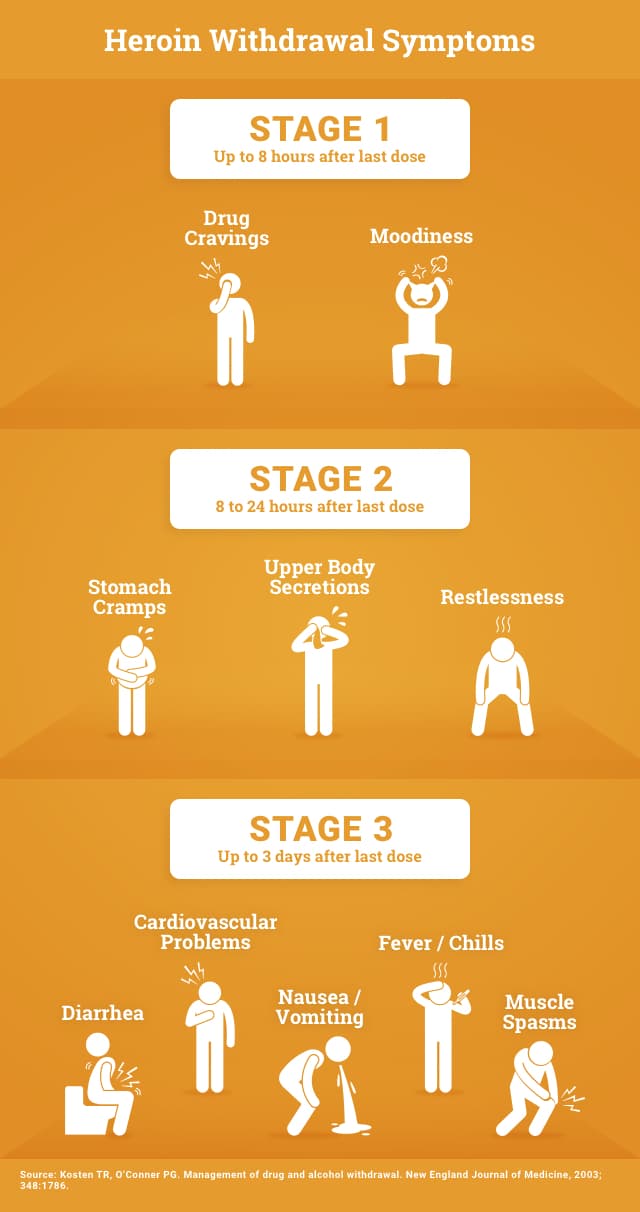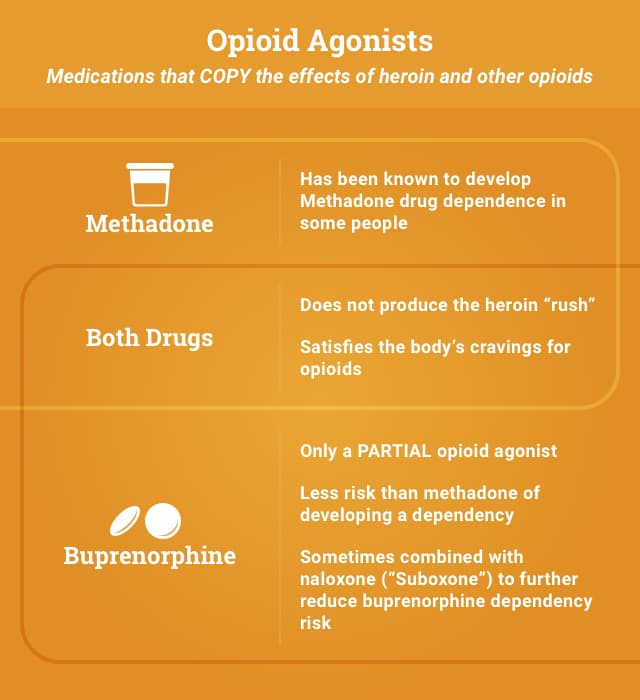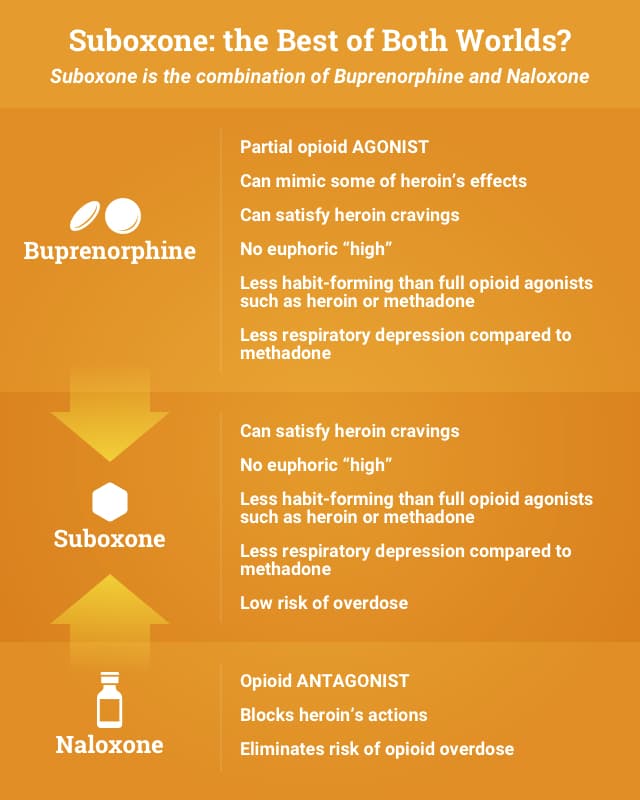The Heroin Detox Process
This first step in the treatment process is a crucial aspect of recovery. Heroin detox may be uncomfortable for users, but there are ways to ease the unpleasant withdrawal symptoms that may arise during this process. Detox marks the beginning of a new and restored life without drugs and is well worth the temporary discomfort.

What Is Heroin Detox?
Detoxification is the process of clearing the body of a particular substance. As heroin leaves the body, a user will experience uncomfortable side effects – also called “withdrawal symptoms.” Withdrawal is the body’s way of demanding more heroin during detox.
While heroin withdrawal is rarely life threatening, it can be unpleasant, especially for heavy users.
Most users will feel their first withdrawal symptoms anywhere from 6-12 hours after their last heroin use. If you stop heroin “cold turkey,” without the assistance of any medications, withdrawal symptoms tend to reach their peak at about 3-4 days after your last heroin use.
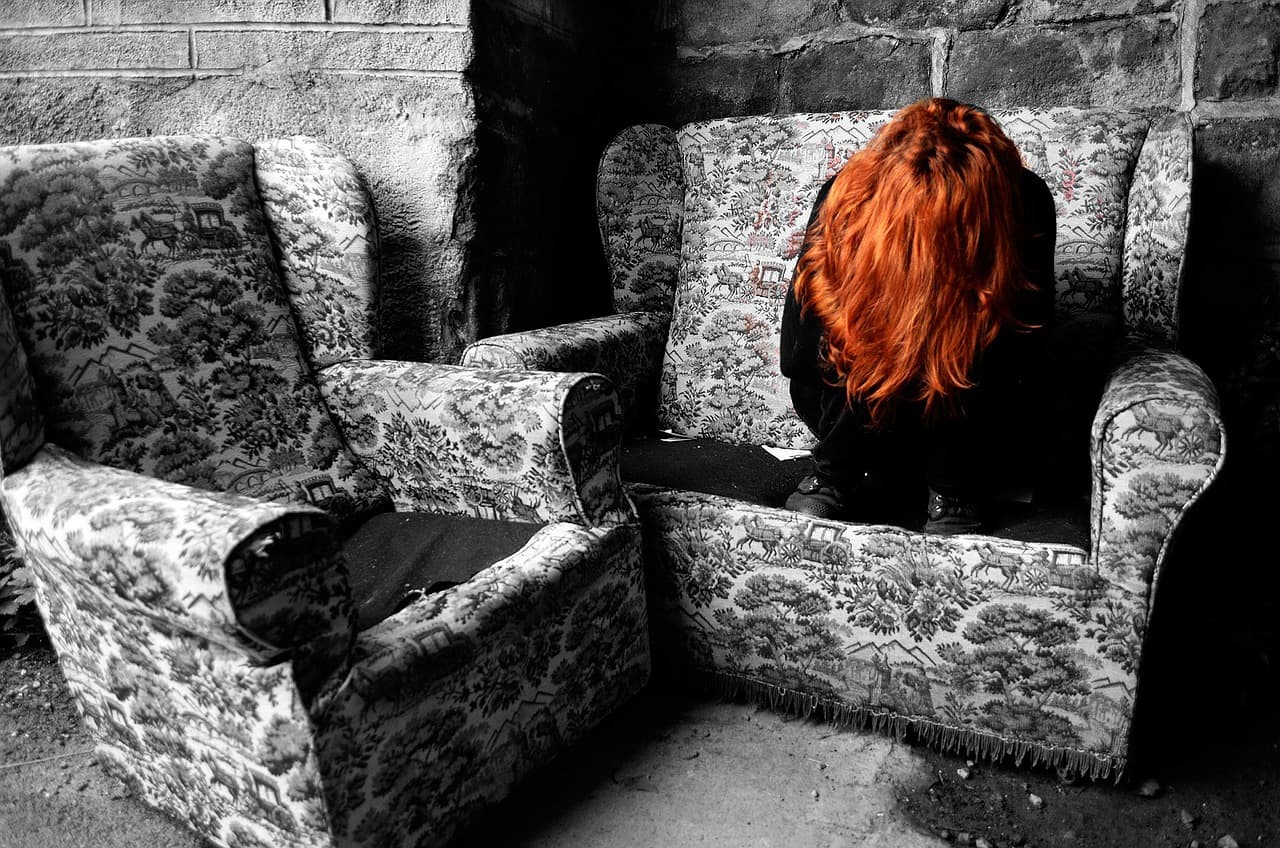
Detox Methods
Different types of professional detox methods will address and, to varying degrees, ease withdrawal symptoms to varying degrees1:
Inpatient Detox

As an inpatient, the heroin user undergoes detox in a hospital or other inpatient facility with medical supervision so the patient may be safely monitored, withdrawal symptoms are managed.
Drugs are usually administered throughout this treatment process to help ease the user off of heroin. In most cases, “opioid agonists” (such as methadone and buprenorphine) are the medications of choice.
These medications mildly mimic the effects of heroin, helping to ease the withdrawal process while diminishing the urge for continued heroin use.
Inpatient detox is recommended for heavy or long-term users, as users’ more severe withdrawal symptoms would benefit from 24/7 medical monitoring.
Outpatient Detox
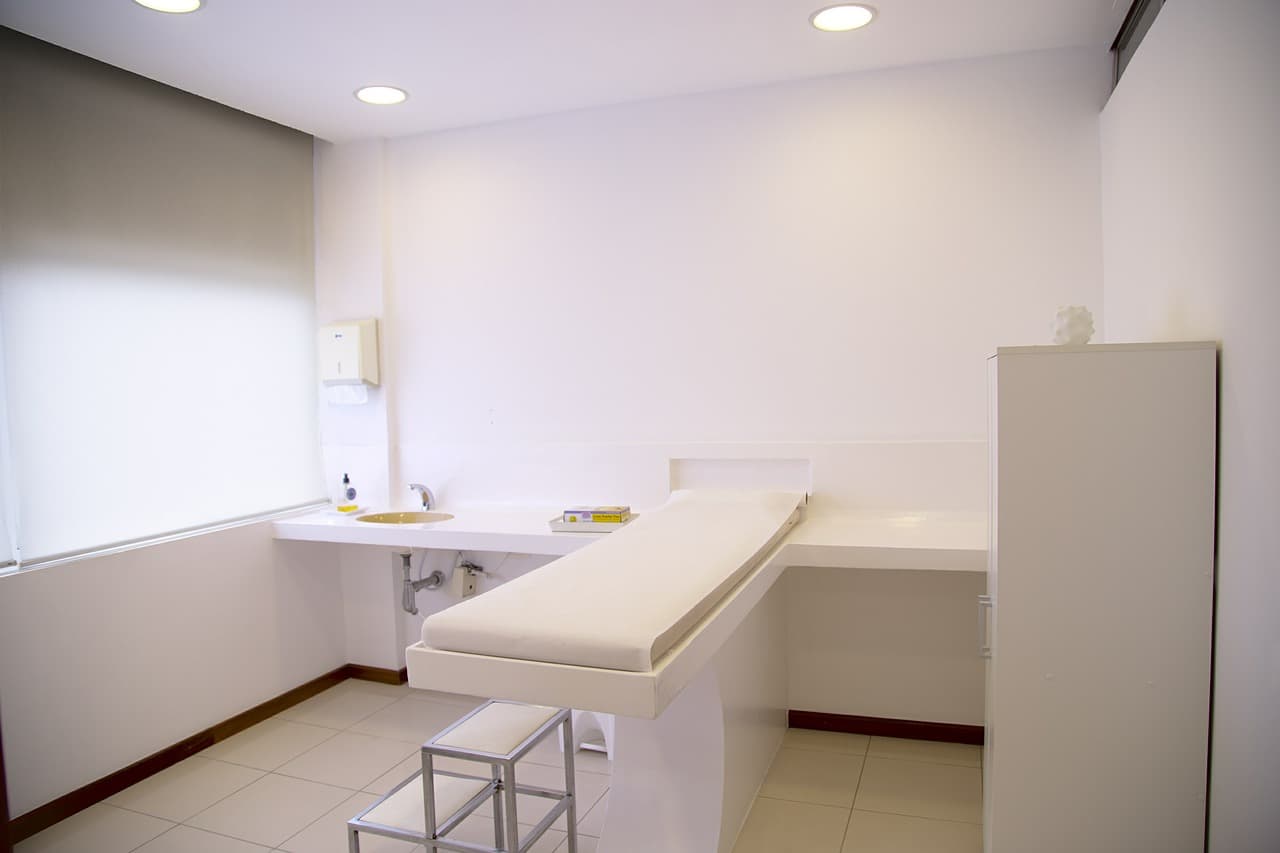
In outpatient detox, heroin users go through heroin detox at home with pharmaceutical assistance that helps decrease withdrawal symptoms. Similar to inpatient detox, opioid agonists are also frequently used in outpatient detox. Those undergoing an outpatient detox will continue to have frequent clinical check-ins to monitor progress and will be able to return home each day.
Outpatient detox tends to work better for people who are relatively new heroin users, or for people who only experience mild to moderate withdrawal symptoms.
A heavy or long-term user, however, would more likely succeed with an inpatient medical detox program.
Rapid Detox
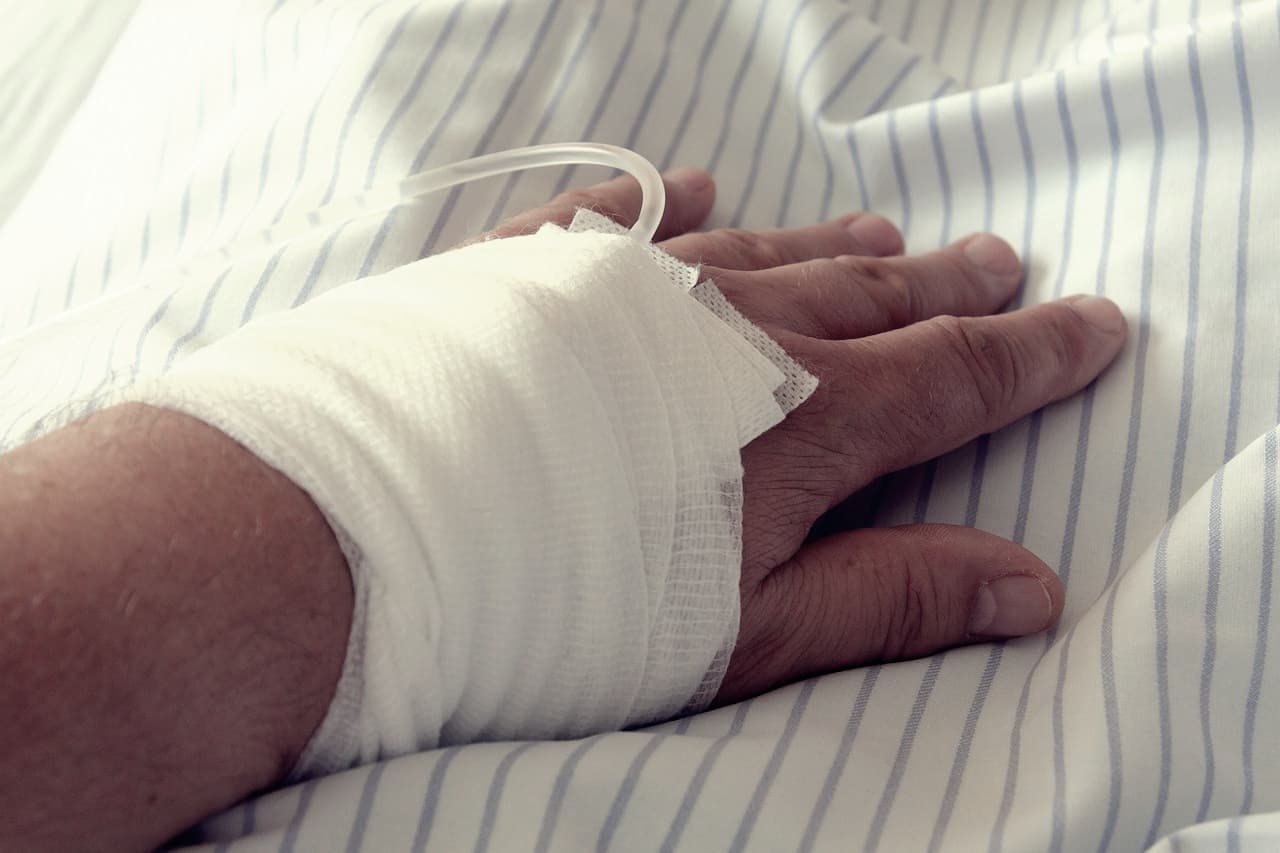
Rapid detox has been used to more quickly get users past the detox process and into a treatment maintenance phase.2 Treatment typically involves the use of medications that are “opioid antagonists” (such as naloxone or naltrexone plus clonidine). Opioid antagonists block the actions of heroin.
Rapidly infused naloxone can occasionally cause a sudden release of catecholamines (“fight or flight” chemicals) in certain individuals, which can potentially result in pulmonary edema or cardiac arrhythmias – a risk that some might prefer not to take.3
Anesthesia-assisted Rapid Detox
Similar to rapid detox, patients undergoing anesthesia-assisted rapid detox are also given opioid antagonists – but they are additionally put under general anesthesia.
Patients may also be given other medications to ease the discomfort of withdrawal.
This type of detox is exceedingly quick – with physical elimination of the drug from the body occurring within 4 to 8 hours (although it should be noted that this step only marks the beginning of recovery).
Anesthesia-assisted rapid detox is controversial and exceedingly risky – especially if it is not professionally monitored.4 For this reason, anesthesia-assisted rapid detox is not recommended.
One study showed that 8.6% of those who underwent anesthesia-assisted rapid detox either developed cardiac arrest or died.5
How Long Does Heroin Detox Take?
Heroin detox takes different amounts of time for different people, depending on a number of factors including:
- The user’s metabolism.
- The user’s height.
- The user’s weight.
- The amount of heroin taken.
- The duration of heroin use.
- The quality of heroin that was used.
- The method of heroin withdrawal.
The duration of pharmaceutically tapered detox can last from 4 hours to 4 weeks, depending on the specific withdrawal medication used and the individual’s particular treatment plan.6
It’s important to remember that detox is only one small part of substance abuse treatment and recovery. There is a lot more to addiction treatment than simply washing the drug out of the body.
What Will I Feel During Heroin Detox?
As heroin leaves the body, a person may start to experience some very uncomfortable withdrawal effects. Because heroin is an addictive substance, the body responds as if it needs the drug, resulting in a number of symptoms – usually beginning at 6-12 hours after the last heroin dose.
Common Withdrawal Symptoms
Typical withdrawal symptoms to expect during detox include5,7:
Up to 8 hours after the last heroin dose
- Intense drug cravings.
- Moodiness: anxiety, depression and fear of withdrawal.
8-24 hours after the last heroin dose
- Stomach cramps.
- Upper body secretions: sweating, watery eyes and runny nose.
- Restlessness: yawning and insomnia.
Up to 3 days after the last heroin dose
- Diarrhea.
- Fever and chills.
- Muscle spasms: joint pain and tremor.
- Nausea and vomiting.
- Cardiovascular problems: increased heart rate and blood pressure.
Heroin withdrawal symptoms are, in many ways, similar to flu symptoms – with heavy, long-term heroin users often experiencing a more intense version of these symptoms. These withdrawal symptoms are usually not life-threatening.4
How Long Do Withdrawal Symptoms Last?
Heroin withdrawal can take a different amount of time for each person. For those attempting to quit heroin without medications, symptom intensity for the ensuing heroin withdrawal tends to peak around 3-4 days after the last heroin use for those coming off of heroin without medications.
Withdrawal symptoms from abrupt, non-medically assisted heroin detox typically resolve in a shorter time than those in medically-assisted detox – however, the severity of withdrawal symptoms experienced during the course of a natural withdrawal will tend to be much stronger.
Many users find withdrawal so uncomfortable that they take more heroin to alleviate the discomfort.
Why Heroin Relapse is Dangerous
The biggest concern regarding heroin withdrawal is the return to drug use. One real danger in this decision is an increased likelihood of overdose.
The Relapse and Overdose Death Connection
Most heroin overdose deaths occur when a person relapses – the body and brain have been reset back to a lower tolerance level than what the body was used to at regular, high doses of heroin.
When individuals later use heroin again following a period of drug abstinence (such as detox), they will often take the same amount of heroin that they were using right before detox. Since the body is no longer used to such a high dose, the likelihood of overdose and death is much higher.4
Let’s verify your coverage for treatment at an American Addiction Centers location. Your information is always confidential.
How Can I Get off Heroin More Comfortably?
While heroin withdrawal can be an uncomfortable flu-like experience to endure – especially when attempted solo – it is a very important first step on the road to recovery. Detox can be made a much more comfortable experience, however, with supervision and medical assistance.
Detox can be made a much more comfortable experience, however, with supervision and medical assistance.
Some examples of medical assistance include:
- Inpatient facilities: Going through detox at an inpatient facility is not only safer, but it also provides professional health monitoring during the unpleasant withdrawal process.
- Drug replacement therapy: To help ease the body off heroin, certain drugs can be prescribed (opioid agonists) that will mimic the effects of heroin so that the body does not suffer an immediate drop-off of heroin effects. This leads to an easier withdrawal experience.
Medications That Can Help with Detox
Medications used to help ease detox and withdrawal effects work by either alleviating the symptoms of withdrawal or by mimicking the effects of heroin (to a lesser degree). These drugs must be taken as prescribed. If replacement drugs are not used as directed by a medical professional, a heroin user may run the risk of developing yet another drug dependency. Common medications used to help ease the withdrawal symptoms throughout detox include the following8:
Opioid Agonists
Opioid agonist medications work by mimicking or partially mimicking the effects of heroin.
Methadone (Dolophine or Methadose):
Methadone does not produce the same “rush” as heroin, but it does still satisfy the body’s cravings for opioids. Methadone activates the same receptors as heroin, but much slower and less intensely. Often patients also require an analgesic medication to help manage pain from coexisting conditions. Certain individuals may develop a medication dependence with methadone.
Once individuals are initially stabilized with a dose of methadone similar to their regular dose of heroin, the daily dose of methadone is ideally tapered down by about 10% per day over the course of about 20 days. Methadone has been found to help people stay in treatment longer and reduces heroin use.9,10
Buprenorphine (Subutex):
Buprenorphine is a partial opioid agonist. Similar to methadone, buprenorphine alleviates a heroin user’s cravings without producing any sort of euphoric “high.” It also does not have many of the risky side effects that other opioids do. Patients are first stabilized on buprenorphine before they are gradually tapered down to lower doses.
Buprenorphine relieves a heroin user’s cravings but does not carry the same risks as methadone for developing a medication dependency.
Patients on buprenorphine who have been tapered down over 4 weeks rather than 1-2 weeks appear to have the best heroin abstinence rates.11
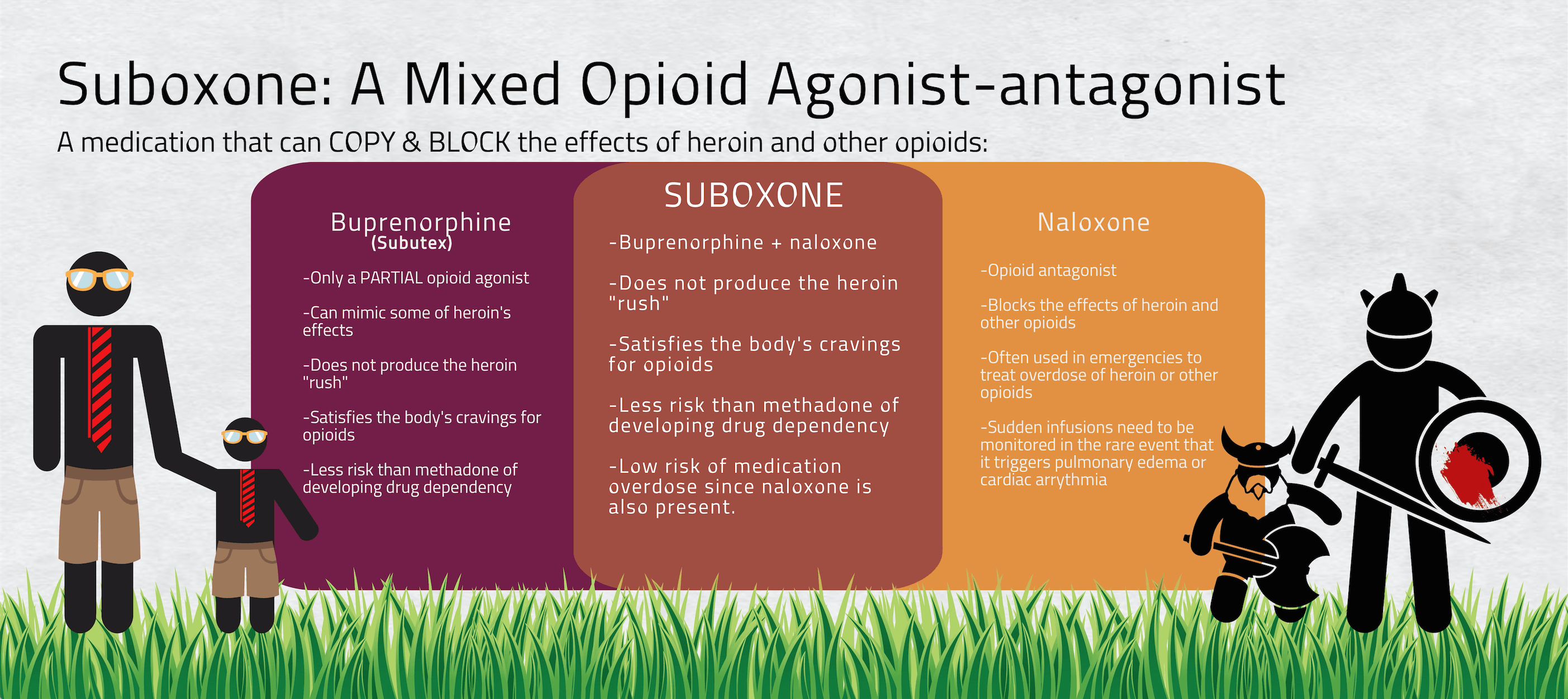
Buprenorphine is often taken with naloxone (as the combined formulation “Suboxone,” described below) and has been shown to be very effective for the treatment of heroin dependence, especially when used in conjunction with counseling.10,12-15
Opioid Antagonists
Opioid antagonist medications work by blocking heroin’s action on opioid receptors.
Naloxone
Naloxone is often used in emergency overdose situations, used during rapid detox alone or in combination with buprenorphine (often administered as Suboxone).
While Naloxone has been effective enough to become part of the U.S.’s routine heroin overdose emergency protocol, its sudden infusion can be risky in certain individuals. A sudden release of catecholamines can be triggered that is severe enough to cause pulmonary edema and cardiac arrhythmias.3
Naltrexone (Depade or ReVia)
Similar to Naloxone, Naltrexone also blocks the receptors that heroin works on, blocking the action of the drug and preventing any sort of euphoric “high” from opioid use. It does not lead to dependence – a risk that the opioid agonist “stabilizers” or “maintenance” medications used for heroin treatment can sometimes pose. One particular form of naltrexone is an injectable, long-lasting version called Vivitrol, which is given once a month.
Some studies have found naltrexone to be less effective than replacement drugs such as buprenorphine.16
Mixed Opioid Agonist-antagonists
Mixed opioid agonist-antagonists such as Suboxone contain both an opioid agonist and an opioid antagonist (or opioid blocker). They are believed to reduce heroin cravings while also preventing abuse of opioid medications.
Suboxone
Suboxone is a combination medication containing both buprenorphine (a partial opioid agonist) and naloxone (an opioid blocker). This medication prevents the recovering person from getting the heroin “high” while satisfying the body’s cravings for opioids.
Additionally, the formulation of an opioid agonist with an opioid antagonist substance precludes against potential overdose.
Suboxone has been found to be effective as long as the person sticks to the prescribed treatment plan along with counseling.17
Alpha-2 Agonists
Alpha-2 agonists such as Clonidine work by reducing “fight or flight” chemicals that are present in higher amounts during withdrawal.
Clonidine
Clonidine has a different method of working compared to the other drugs discussed above.
Clonidine works by shutting down the “fight or flight” chemicals in the body and reducing withdrawal symptoms in individuals who take low doses of heroin.18
It’s an “alpha-2 adrenergic receptor agonist” often used to treat hypertension that ultimately decreases the release of catecholamines in the sympathetic nervous system.
Clonidine is not technically U.S. FDA-approved for opioid withdrawal treatment but is still commonly administered for helping with heroin withdrawal.
The Role of Medications in Detox
Drug replacement is often used in combination with therapy to produce the best possible recovery results. Medications can help a lot with detox and withdrawal, but their usefulness can also extend further into the treatment course. Additionally, some individuals with severe heroin addiction may be recommended for ongoing methadone maintenance therapy to prevent heroin relapse.
In either case, treatment facilities provide a number of extra helps for recovering heroin users who are using medication replacement.19 Whether heroin detox is pursued without medications or with medications, a person who has used heroin can indeed work towards recovery and find a satisfying sober life without drugs. Find out more about what other treatment options exist for heroin abuse.
Learn More About Your Next Steps with Heroin Detox
If heroin has impacted your life or the life of a loved one, let today be your day for seeking more information about the heroin detox and treatment process. One of our caring recovery advisors is ready to help you learn about what the next steps towards recovery could involve for you.

- Heroin Withdrawal
- Comorbidity With Heroin Addiction
- Cost of Heroin Addiction
- How to Talk to a Heroin User
- Clonidine Guide
- Naloxone Guide
- Detoxing Safely from Heroin
- Suboxone Detox
- Rapid Detox
- Heroin Detox Medications
- Heroin Addiction Intervention
- Heroin Addiction Helpline
- Detox vs Treatment
- Heroin Addiction Treatment
Sources
- Opiate detoxification. The Addiction Recovery Guide.
- Loimer N, Linzmayer L, Schmid R, Grunberger J. Similar efficacy of abrupt and gradual opiate detoxification. Am J Drug Alcohol Abuse. 1991;17(3):307.
- Van Dorp E, Yassen A, Dahan A. Naloxone treatment in opioid addiction: the risks and benefits. Expert Opin Drug Saf. 2007 Mar;6(2):125-32.
- Opiate withdrawal. Medline Plus.
- Collins ED, Kleber HD, Whittlington RA, Heitler NE. Anesthesia-assisted vs buprenorphine- or clonidine-assisted heroin detoxification and naltrexone induction: a randomized trial. JAMA 2005;294(8):903.
- Kosten TR, O’Connor PG. Management of drug and alcohol withdrawal. N Engl J Med. 2003;348(18):1786.
- Commonly abused drug charts. National Institute on Drug Abuse.
- What are the treatments for heroin addiction? National Institute on Drug Abuse.
- Mattick RP, Breen C, Kimber J, Davoli M. (2003). Methadone maintenance therapy versus no opioid replacement therapy for opioid dependence. Cochrane Database of Systematic Reviews, CD002209.
- Mattick, R. P., Kimber, J., Breen, C., & Davoli, M. (2008). Buprenorphine maintenance versus placebo or methadone maintenance for opioid dependence. Cochrane Database of Systematic Reviews, 16 (2), CD002207.
- Sigmon SC, Dunn KE, Saulsgiver K, Patrick ME, Badger GJ, Heil SH, et al. A randomized, double-blind evaluation of buprenorphine taper duration in primary prescription opioid abusers. JAMA Psychiatry. 2013;70(12):1347.
- Amass, L., Kamien, J. B., & Mikulich, S. K. (2000). Efficacy of daily and alternate-day dosing regimens with the combination buprenorphine–naloxone tablet. Drug and Alcohol Dependence, 58 (1–2), 143–152.
- Ling, W., & Wesson, D. R. (2003). Clinical efficacy of buprenorphine: Comparisons to methadone and placebo. Drug and Alcohol Dependence, 70 (2 Suppl.). S49–S57.
- Chawarski MC, Mazlan M, Schottenfeld RS (2008) Behavioral drug and HIV risk reduction counseling (BDRC) with abstinence-contingent take-home buprenorphine: a pilot randomized clinical trial. Drug and Alcohol Dependence, 94. 281–284.
- Barnett PG, Zaric GS, Brandeau M (2001) The cost-effectiveness of buprenorphine maintenance therapy for opiate addiction in the United States. Addiction, 96 (9). 1267–1278.
- Schottenfeld RS, Chawarski MC, Mazlan M (2008). Maintenance treatment with buprenorphine and naltrexone for heroin dependence in Malaysia: a randomized, double-blind, placebo-controlled trial. Lancet, 371 (9631). 2190– 2200.
- Sittambalam, C. D., Vij, R., & Ferguson, R. P. (2014). Buprenorphine outpatient outcomes project: can suboxone be a viable outpatient option for heroin addiction? Journal of Community Hospital Internal Medicine Perspectives, 4 (2).
- Gold MS, Pottash AC, Sweeney DR, Kleber HD. Opiate withdrawal using clonidine. A safe, effective, and rapid nonopiate treatment. JAMA. 1980;243(4):343.
- Oviedo-Joekes, E. et. al. (2015). Predictors of non-use of illicit heroin in opioid injection maintenance treatment of long-term heroin dependence. Addictive Behaviors, 41. 81-86.
Heroin Rehabilitation Directory
Select a state to learn more about your treatment options.- Alabama
- Alaska
- Arizona
- Arkansas
- California
- Colorado
- Connecticut
- Delaware
- District Of Columbia
- Florida
- Georgia
- Hawaii
- Idaho
- Illinois
- Indiana
- Iowa
- Kansas
- Kentucky
- Louisiana
- Maine
- Maryland
- Massachusetts
- Michigan
- Minnesota
- Mississippi
- Missouri
- Montana
- Nebraska
- Nevada
- New Hampshire
- New Jersey
- New Mexico
- New York
- North Carolina
- North Dakota
- Ohio
- Oklahoma
- Oregon
- Pennsylvania
- Rhode Island
- South Carolina
- South Dakota
- Tennessee
- Texas
- Utah
- Vermont
- Virginia
- Washington
- West Virginia
- Wisconsin
- Wyoming
Help for Heroin Addiction
Do you know someone suffering from heroin addiction? Help is available. To find out more, please choose the selection that applies to you or the person suffering from addiction:
Fill out the form below to be contacted.
Repair the damage and start fresh today!


